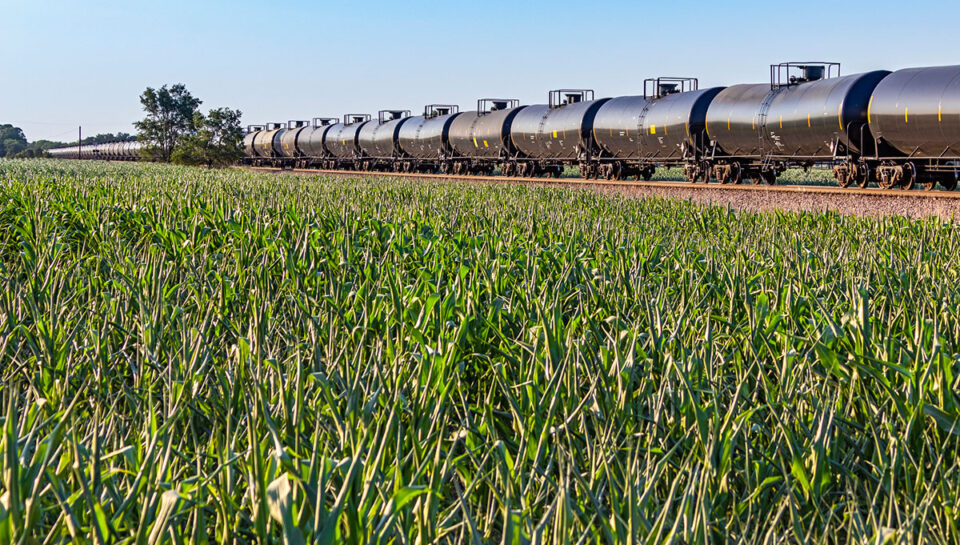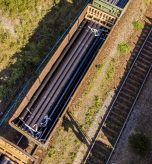Executive Summary
The North American energy landscape is undergoing a profound transformation unlike anything we’ve seen before. This transformation – driven by the shale revolution, decarbonization focus, and Trump administration policy shifts – creates both challenges and opportunities for everyone in the supply chain community. While traditional coal volumes continue their inevitable decline, tremendous growth potential exists in renewable diesel feedstocks, critical minerals, and our booming chemicals sector. This whitepaper examines where our industry stands today and where forward-thinking supply chain leaders should position themselves.
North American Energy Overview
Current State
North America has emerged as an energy powerhouse, not the energy-dependent region many of us started our careers in. The numbers don’t lie – production has reached 13.5 million barrels per day of crude, 103 billion cubic feet of natural gas, and 7.2 million barrels of NGLs. Logistics networks have required complete reconfiguration to handle these volumes. The shale revolution wasn’t just a production shift – it created sustained cost advantages that have transformed our entire business models.
Despite all the talk about renewables (which are indeed growing), fossil fuels still supply nearly 80% of our energy needs. Transportation teams are still primarily moving crude for transportation fuels and natural gas for both power generation and chemical production. This sustained domestic production has fundamentally altered how we must plan and execute our supply chain strategies.
Export Development
Export capabilities are now central to logistics planning. Approximately 4 million barrels of crude move daily to overseas markets, primarily Europe and Asia. Our LNG export operations are world-leading, with about 14% of production now leaving as LNG. This capability proved crucial when shipments needed rapid redirection to support European energy security after Russia’s Ukraine invasion.
NGL export teams are handling record volumes, with over 40% of production now heading overseas. Asia has become our growth market, driving petrochemical feedstock, heating, and cooking applications. And don’t overlook Mexico – it has emerged as a key refined products market due to its proximity and ongoing refinery challenges. The Dos Bocas refinery continues to underperform its 340,000 barrel per day capacity, creating sustained export opportunities for southern corridor logistics operations.
Chemical Industry Impact
The abundance of low-cost gas and NGLs has been a game-changer for chemical operations. Capital planning teams are working overtime managing major investments in new facilities, particularly along the Gulf Coast. Polyethylene capacity expansion has shifted our trade balance positive and substantially increased rail shipments of plastic resins.
With flat domestic demand, nearly all new PE plants are designed for export markets. Supply chain infrastructure planning is already underway for three major projects:
- 2028 – ChevronPhillips/Qatar Energy JV in Orange, TX
- 2028 – Dow in Fort Saskatchewan, Alberta
- 2030 – ExxonMobil in Corpus Christi, TX (tentative)
Decarbonization Initiatives
Policy Framework
The Trump administration’s recent actions signal a major course correction for infrastructure planning. The Unleashing American Energy Executive Order signed January 20th aims at expediting permitting – something project teams across our industry have desperately needed. It’s already simplifying approval processes for interstate energy transportation and critical infrastructure.
With the CEQ’s February 16th interim rule for NEPA implementation review, we’re seeing a clear shift away from the previous administration’s emphasis on greenhouse gas emissions assessment. Regulatory affairs teams report this will significantly streamline our permitting timelines and reduce barriers to infrastructure development.
Federal Energy Regulatory Commission (FERC) Policy Changes
Just four days after the Executive Order, FERC terminated its proceeding on climate change impact assessment for natural gas infrastructure. This withdrawal of the draft GHG Policy Statement means project teams can now expect case-by-case climate impact considerations rather than comprehensive reviews. From a supply chain perspective, this will accelerate our natural gas infrastructure development timelines substantially.
Key Growth Areas
Renewable fuels continue to drive significant activity in supply chain operations. Renewable diesel capacity has expanded rapidly, with consumption reaching approximately 240,000 barrels daily in 2024 – about 9% of total diesel demand. This has dramatically changed feedstock sourcing, with procurement teams scrambling for soybean oil, tallow, and used cooking oil. The U.S. has become a net importer of soybean oil for the first time.
I’m concerned about California’s updated Low Carbon Fuel Standards. Beginning 2028, seed oils will be limited to 20% of renewable diesel/biodiesel blendstock for LCFS credits, which will likely constrain production growth plans.
Energy transition materials represent another area where supply chain capabilities are developing, despite challenges. Rising demand exists for lithium, cobalt, nickel, and copper, though many domestic mining projects remain on hold due to global price volatility.
Battery Electric Storage Systems are critical to renewable energy growth plans, though sourcing teams report continued dependence on Chinese lithium-ion batteries, with China dominating nearly every step of the battery supply chain. This is a vulnerability we need to address.
Rail Transportation Impact
Current Trends
This energy transformation has completely reshaped rail transportation patterns. Coal volumes continue their decline, but chemical and plastic resin shipments have grown substantially. Quarterly carloads for plastics and synthetic resins show consistent growth – a trend I expect to continue for years.
While other energy commodities haven’t fully offset lost coal volumes, shale development has driven growth in LPGs, refined products, and resins, creating new opportunities for rail logistics teams.
Future Opportunities
Here’s what I’m seeing for rail operations:
- Crude Oil: Western Canadian production will exceed pipeline capacity by mid-2026, creating crude-by-rail opportunities to the Gulf Coast. Forward-thinking logistics teams are already securing capacity. You don’t want to be caught flat-footed when this shift happens.
- Propane/Butane: Growing NGL production in the Bakken, Appalachia, and Western Canada, combined with pipeline constraints and terminal expansions, creates rail opportunities. LPG shipments are growing, though seasonality creates planning challenges. We need better solutions for handling these seasonal swings.
- Chemicals: The ethane feedstock advantage will sustain chemical production for decades. Stable rail demand across chemical portfolios should be anticipated. This is one of the most reliable growth areas I’m seeing.
- Renewable Diesel/SAF: These require rail for both feedstocks and finished products, though forecasts should be adjusted based on the LCFS ruling’s impact on feedstock availability. We need to be realistic about these constraints.
- Carbon Capture: This space is growing quickly, from 14 MRV plans in 2024 to a projected 54 by 2028. While pipelines will move most CO2, high-pressure tank cars as virtual pipelines for remote projects are worth investigating, though technical issues with railcar storage capability need resolution. This could be a significant opportunity if we solve these technical challenges.
Challenges and Considerations
Supply chain leaders face several critical challenges. They must balance equipment and infrastructure investment between traditional and emerging markets while adapting to constantly shifting trade flows. Success in this market requires both strategic planning and operational flexibility – something that should be emphasized at every leadership team meeting.
Conclusion
From where I sit, the North American energy transition presents both significant challenges and compelling opportunities. While coal shipments continue to decline, promising growth exists in renewable fuels, energy transition materials, and chemicals. The continued strength of U.S. energy exports, particularly LNG, NGLs, and chemicals, will support rail transportation demand.
To succeed in this environment, strategic equipment and infrastructure investment must be prioritized while maintaining operational flexibility to adapt to shifting commodity flows. Those supply chain organizations that position themselves to serve these emerging markets while managing traditional energy commodities will be best positioned for long-term success in this rapidly evolving energy landscape. The winners and losers in our industry will be determined by who acts decisively now.















